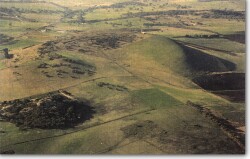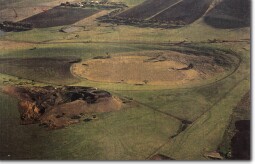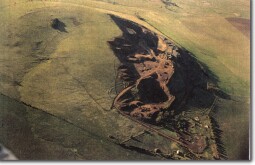Mount Anakie
|
This information has been obtained from the report: Eruption Points of the Newer Volcanic Province of Victoria by Neville Rosengren. This report was published in 1994 and was prepared for the National Trust of Australia (Victoria) and the Geological Society of Australia (Victorian Division). The review of eruption points was based on an earlier unpublished manuscript Catalogue of the post-Miocene volcanoes of Victoria compiled by O P Singleton and E B Joyce (Geology Department, University of Melbourne 1970). |
| The Anakies. | 37 53 14S 144 15 59E (external link); 7722-2-3 (ANAKIE) 597032. 31 km N of Geelong. Geelong-Ballan Road, Mount Road. Corio |  Mt Anakie (Western and highest summit) [Anakie 1] |
Private land: | Public road crosses between craters and gives view of main features. Bare, outcrop, grazing, two quarries, communications tower on highest cone. | |
Type 9: | Composite scoria cones and maar overlying lava flows. | |
Four eruption points (three scoria cones and a small enclosed depression - probably a maar) are aligned southeast/northeast over a distance of 5 km. This alignment may be controlled by a fracture system in the granite bedrock. The highest cone (in the northwest) has a broad shallow crater open to the south. The crater form is partly due to mounds of scoria heaped on the northern side and to erosion by a stream developing in the southern slopes. The slopes of the highest cone are usually steep due to the coarseness of the scoria and the degree of welded spatter. The scoria of the other cones is less welded but they are partly stabilised by layers and dykes of lava in the upper slopes. The scoria of all cones contains abundant rounded bombs with cores of basalt, olivine, granite or clay. An oval-shaped swampy depression 400 m x 700 m is surrounded by a low rim of scoria and bedded ash or tuff. The depression is probably a steam explosion crater or small maar. The Anakies are an important source of lherzolite xenoliths and rare composite xenoliths. Granitic rocks underlie the volcanoes and form tors and slabs at “Fairy Park” adjacent to the scoria cones. | ||
398 m; 170 m. | ||
State: | Only Mount Anakie (northern cone) and the maar are regarded as significant. Mount Anakie is a prominent eruption point and one of the few scoria volcanoes on the Werribee Plains. The maar crater is an unusual feature and is the smallest of its type in Victoria. All other maars are noted as being early in the eruptive sequence but the form, position and state of preservation of this crater suggests it is one of the youngest eruptive features here. The origin and morphology of the feature warrant further investigation. | |
The close proximity and alignment of vents is unusual in the Newer Volcanics of the plains of western Victoria. This is a noted megacryst site. It is also an important teaching locality in close proximity to Melbourne and Geelong. Lava from the Anakies is warped on the scarp of the Rowsley Fault indicating recent activity of that fault. | ||
References: | Coulson, A. 1938. The basalts of the Geelong district. Proceedings of the Royal Society of Victoria 50, pp. 251-257. Ollier, C.D. & Joyce, E.B. 1964. Volcanic Physiography of the Western Plains of Victoria. Proceedings of the Royal Society of Victoria 77, pp. 357-376. Ollier, C.D. 1967a. Landforms of the Newer Volcanics Province of Victoria. In J.N. Jennings & J.A. Mabbutt (eds), Landform studies from Australia and New Guinea. ANU Press, pp. 315-339. Bolger, P. 1977. Explanatory notes on the Meredith and You Yangs 1:50 000 geological maps. Geological Survey of Victoria Report 1977/14. Price, R.C. Gray, C.M., Nicholls, I.A. & Day, A. 1988. Cainozoic volcanic rocks. In J.G. Douglas and J.A. Ferguson (eds) Geology of Victoria. Geological Society of Australia, Victorian Divsion, Melbourne, pp. 439-451. | |
 Mt Anakie Maar and Quarry on middle hill (Anakie 2) |  Mt Anakie 3 (easternmost hill) and large quarry |


